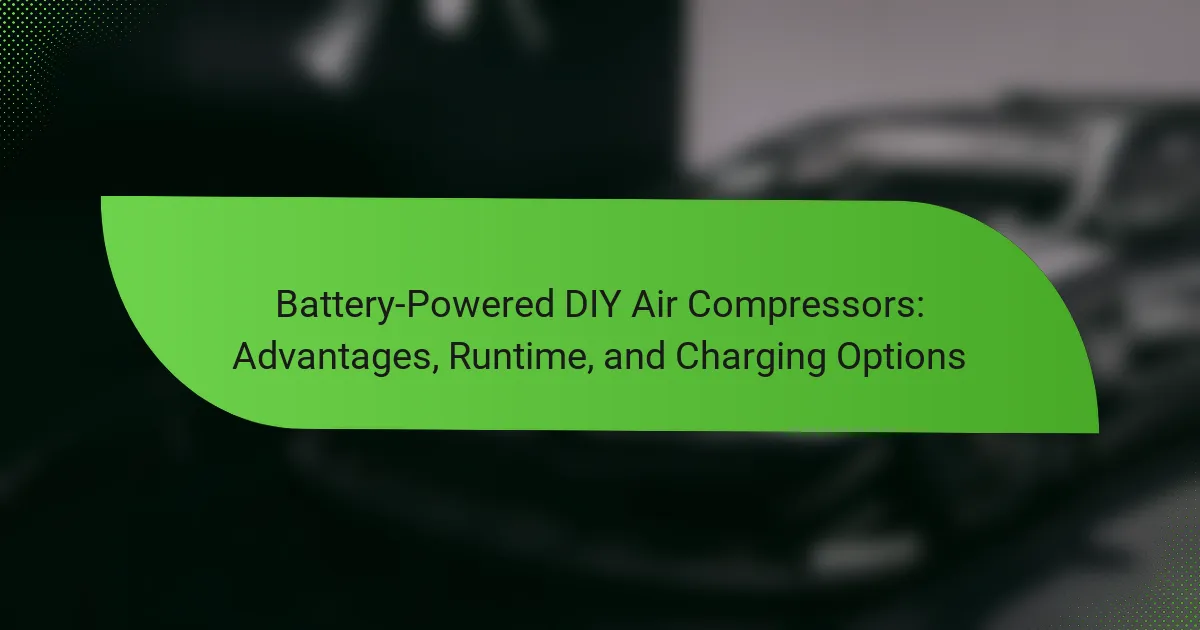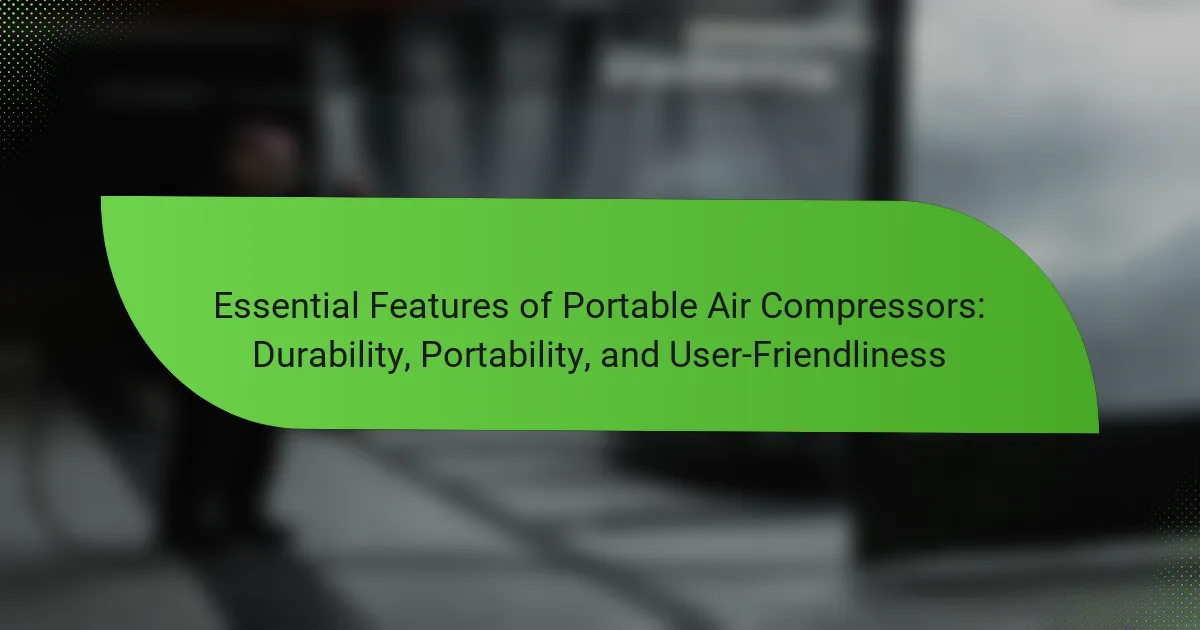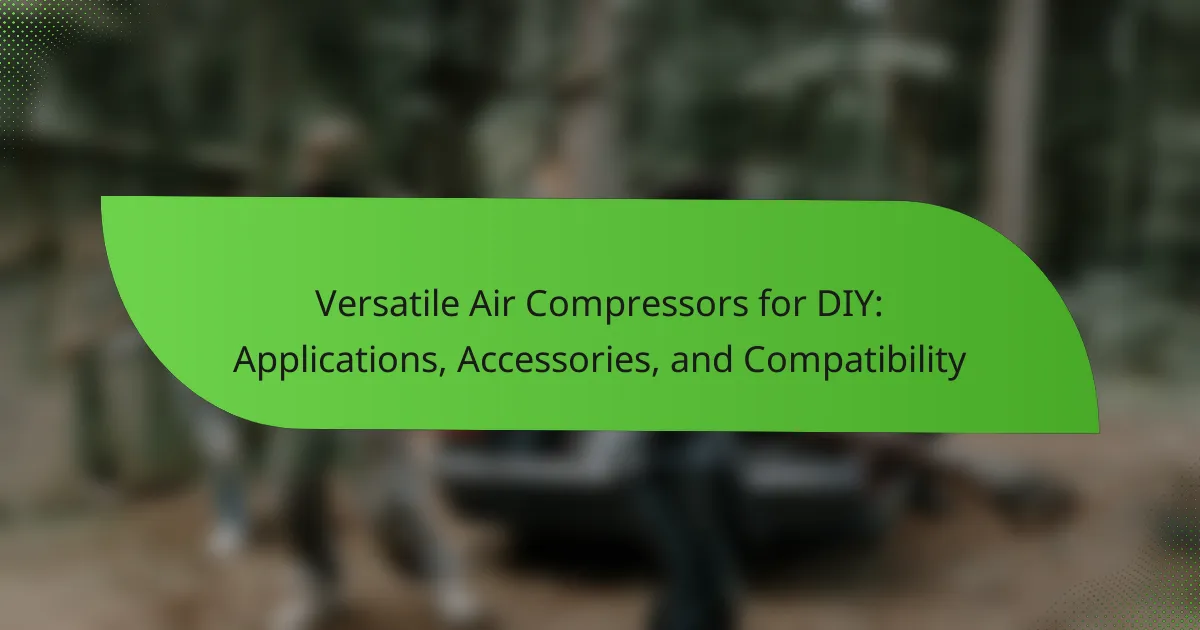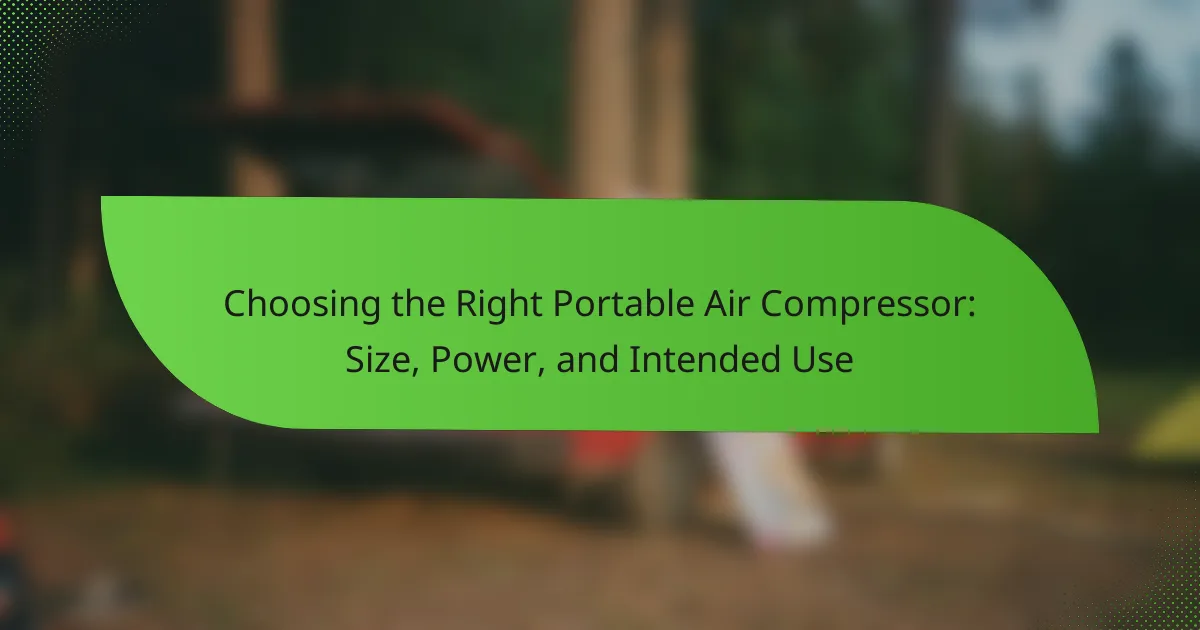Quiet portable air compressors are compact devices that compress air while minimizing noise output, making them suitable for indoor use and environments where noise reduction is crucial. These compressors utilize advanced technologies, including oil-free pumps and sound-dampening materials, to operate at noise levels often below 60 decibels. Their portability allows for easy transportation, making them ideal for various applications such as inflating tires, powering pneumatic tools, and supporting home improvement projects. When selecting a quiet portable air compressor, important factors to consider include noise level, portability, power output, tank size, and motor type, which collectively ensure efficiency and reliability in quieter working environments.
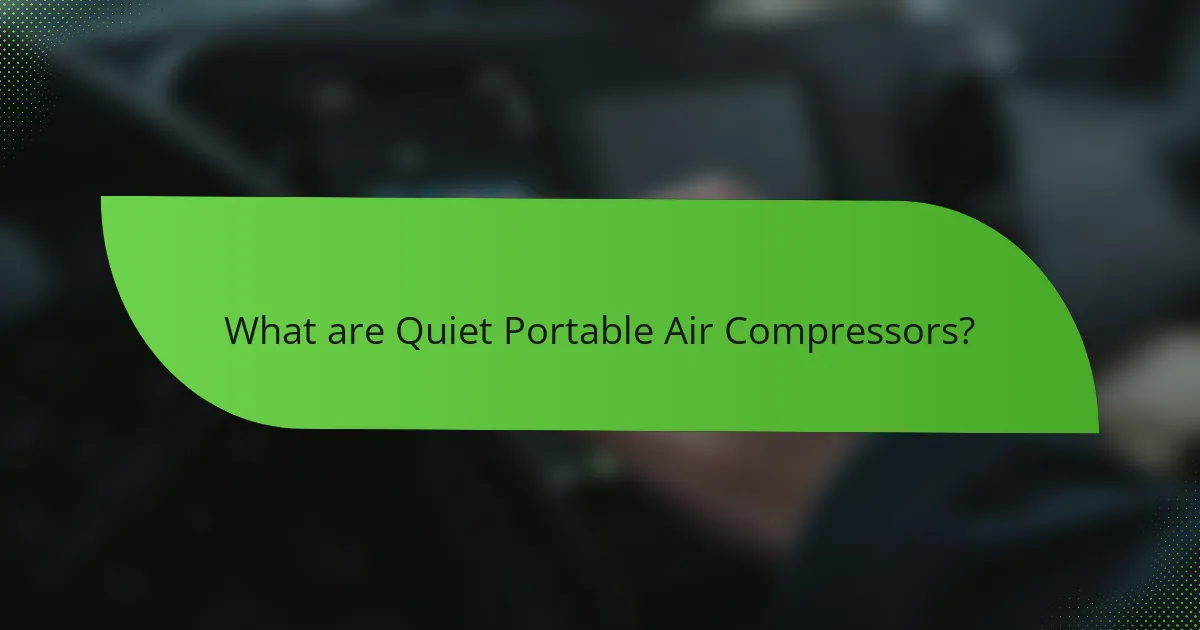
What are Quiet Portable Air Compressors?
Quiet portable air compressors are compact devices designed to compress air with minimal noise output. They are ideal for indoor use or environments where noise reduction is essential. These compressors typically employ advanced technology, such as oil-free pumps or sound-dampening materials, to achieve lower decibel levels. Many models operate at noise levels below 60 decibels, making them suitable for home and workshop applications. Their portability allows for easy transportation and use in various locations. Quiet portable air compressors are commonly used for inflating tires, powering pneumatic tools, and other air-related tasks. Their efficiency and reduced noise make them increasingly popular among users seeking convenience and a quieter working environment.
How do Quiet Portable Air Compressors differ from traditional models?
Quiet portable air compressors differ from traditional models primarily in their noise levels. Traditional air compressors typically operate at 70 to 90 decibels, which can be disruptive. In contrast, quiet portable air compressors are designed to operate at 50 to 60 decibels. This significant reduction in noise makes them more suitable for residential and indoor use.
Additionally, quiet models often utilize advanced technology, such as oil-free pumps and sound-dampening enclosures. These features contribute to their lower noise output while maintaining efficiency. Many quiet portable air compressors also prioritize portability, being lightweight and compact for easy transport.
This combination of reduced noise, advanced technology, and portability distinguishes quiet portable air compressors from their traditional counterparts.
What are the key characteristics of Quiet Portable Air Compressors?
Quiet portable air compressors are designed to operate at lower noise levels compared to standard models. They typically feature sound-dampening technology that reduces operational noise to around 60 decibels or less. This makes them suitable for indoor use and residential areas. Many models are lightweight and compact, enhancing portability for various applications. They often come with oil-free pumps, which require less maintenance and prevent oil contamination. Quiet portable air compressors usually have a range of power outputs, allowing them to handle different tasks efficiently. Additionally, they may include features like multiple pressure settings and quick-connect couplers for ease of use. These characteristics make them ideal for DIY projects, inflation tasks, and powering pneumatic tools.
What makes a compressor ‘quiet’ in terms of design and technology?
A compressor is considered ‘quiet’ due to specific design features and technological advancements. Key factors include sound insulation materials that absorb noise. Additionally, a well-designed motor and pump can minimize vibrations. The use of oil-lubricated pumps reduces friction and noise. Advanced acoustic engineering also plays a role in sound dampening. Compressors with lower RPMs typically operate more quietly. Furthermore, the design of the housing can significantly impact noise levels. These elements collectively contribute to a quieter operation, making the compressor more user-friendly in noise-sensitive environments.
What are the typical noise levels of Quiet Portable Air Compressors?
Typical noise levels of quiet portable air compressors range from 60 to 70 decibels. This level is comparable to normal conversation or background music. Many models are designed to operate quietly for user convenience. For example, some compressors use advanced technology to minimize sound. This makes them suitable for indoor use or residential areas. Users appreciate the reduced noise during operation. Overall, quiet portable air compressors provide effective performance with lower noise output.
How are noise levels measured for air compressors?
Noise levels for air compressors are measured using a sound level meter. This device captures sound pressure levels in decibels (dB). Measurements are typically taken at a distance of 1 meter from the compressor. The meter records the sound levels during the compressor’s operation. Standard testing conditions often include a controlled environment. Noise levels can vary based on the compressor’s design and motor type. For instance, oil-lubricated compressors generally produce less noise than direct-drive models. Manufacturers often provide noise ratings in their specifications. This allows users to compare different models effectively.
What noise level is considered acceptable for residential use?
An acceptable noise level for residential use is typically around 50 to 60 decibels. This range is considered comfortable for most household activities. Noise levels above 70 decibels can be disruptive and may lead to complaints from neighbors. Studies show that prolonged exposure to noise levels above 65 decibels can affect sleep and overall well-being. Local regulations often set specific limits for noise in residential areas. For example, many municipalities enforce noise ordinances that restrict noise during nighttime hours. Maintaining noise levels within this range promotes a peaceful living environment.
What technologies are used in Quiet Portable Air Compressors?
Quiet portable air compressors utilize several advanced technologies to minimize noise and enhance performance. Key technologies include oil-free pumps, which reduce noise levels and maintenance needs. They often incorporate sound-dampening materials in their design to further lower operational sound. Additionally, brushless motors are frequently used for their efficiency and quiet operation. Some models feature variable speed technology, allowing for quieter performance at lower power levels. These compressors are designed with advanced heat dissipation systems to prevent overheating while maintaining a low noise profile. Overall, these technologies contribute to quieter, more efficient air compression solutions.
How does the motor type affect the noise output?
The motor type significantly affects the noise output of air compressors. Electric motors typically produce less noise compared to gas engines. This is due to the absence of combustion, which generates additional sound in gas-powered models. For instance, electric compressors often operate at noise levels around 60-70 decibels. In contrast, gas-powered compressors can reach 80 decibels or more. Additionally, rotary screw motors tend to be quieter than reciprocating piston motors. The design and insulation of the motor also contribute to overall noise levels. Therefore, selecting the right motor type is crucial for minimizing noise output in portable air compressors.
What role does sound insulation play in compressor design?
Sound insulation is crucial in compressor design to minimize operational noise. Compressors generate significant sound during operation. Effective sound insulation materials reduce this noise, enhancing user comfort. It also allows for use in noise-sensitive environments. Studies indicate that well-insulated compressors can reduce noise levels by up to 20 dB. This reduction improves compliance with local noise regulations. Additionally, sound insulation can enhance the lifespan of components by reducing vibration. Overall, sound insulation plays a vital role in improving the usability and marketability of compressors.
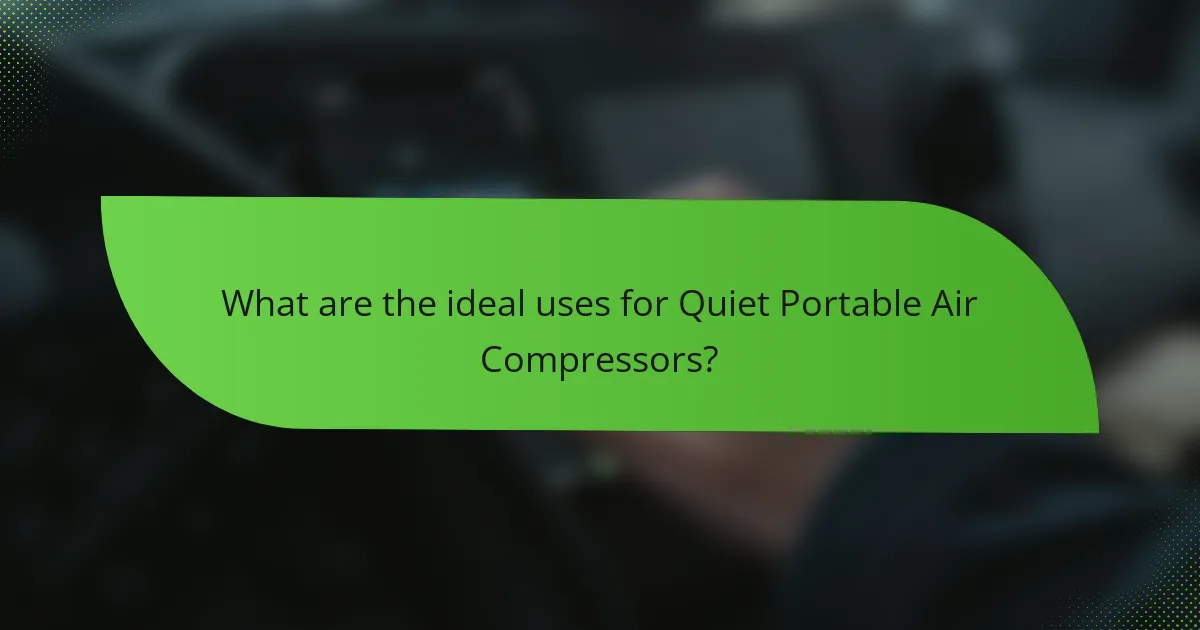
What are the ideal uses for Quiet Portable Air Compressors?
Quiet portable air compressors are ideal for various applications that require minimal noise disruption. They are perfect for indoor use, such as inflating tires or sports equipment. Their low noise levels make them suitable for residential areas and workshops. Quiet portable air compressors are also effective for powering air tools in home improvement projects. They can be used for painting tasks, ensuring a quieter environment. Additionally, they are beneficial for inflating air mattresses and other camping gear. Their portability allows for easy transport to different locations. Overall, their design caters to users who prioritize noise reduction without sacrificing performance.
How can Quiet Portable Air Compressors be utilized in home settings?
Quiet portable air compressors can be utilized in home settings for various tasks. They are ideal for inflating tires, sports equipment, and inflatable toys. Their low noise levels make them suitable for use in residential areas without disturbing neighbors. Homeowners can also use them for powering air tools for light DIY projects. Additionally, they can assist in maintaining air pressure in pneumatic systems. With features like portability, they can be easily moved from one location to another within the home. Many models are designed for easy storage, making them convenient for limited spaces. Their versatility allows for multiple applications in a home environment.
What tasks can be performed using these compressors at home?
Quiet portable air compressors can perform various tasks at home. They are ideal for inflating tires of bicycles and cars. These compressors can also inflate sports equipment like balls and inflatable toys. They are useful for powering air tools, such as nail guns and spray guns. Additionally, they can assist in cleaning hard-to-reach areas with air dusters. Quiet models minimize noise, making them suitable for indoor use. Their portability allows easy transport around the house. These compressors enhance DIY projects by providing consistent air pressure. Overall, they are versatile tools for home maintenance and recreational activities.
How do Quiet Portable Air Compressors enhance DIY projects?
Quiet portable air compressors enhance DIY projects by providing a reliable and efficient power source. They operate at lower noise levels, allowing users to work in residential areas without disturbing neighbors. Their portability enables easy transport between job sites, making them convenient for various tasks. Many models are lightweight, which simplifies handling and setup. Quiet compressors often feature advanced technology that improves energy efficiency. This efficiency can lead to cost savings on electricity bills during prolonged use. Additionally, these compressors can power a variety of tools, such as nail guns and spray painters, enhancing the versatility of DIY projects. Their user-friendly design often includes features like easy-to-read gauges and quick-connect fittings, further streamlining the DIY process.
What are the professional applications of Quiet Portable Air Compressors?
Quiet portable air compressors are used in various professional applications. They are ideal for tasks requiring minimal noise disruption, such as residential construction and woodworking. These compressors are often utilized for inflating tires and sports equipment in automotive and recreational settings. They are also effective for powering pneumatic tools in small workshops. Additionally, they serve well in photography and videography, where quiet operation is essential. The low noise levels enhance comfort in environments like hospitals and schools. Their portability makes them suitable for on-site jobs and remote locations. Overall, quiet portable air compressors combine efficiency with discretion across multiple professional fields.
Which industries benefit from using Quiet Portable Air Compressors?
Several industries benefit from using Quiet Portable Air Compressors. The construction industry utilizes these compressors for tasks requiring minimal noise disruption. In the automotive sector, they are used for tire inflation and paint spraying. The woodworking industry benefits from their use in pneumatic tools without excess noise. Additionally, the medical field employs them for powering equipment in sensitive environments. The photography industry also uses quiet compressors for inflating backdrops and other equipment discreetly. These applications highlight the versatility and importance of quiet portable air compressors across various sectors.
How do these compressors improve working conditions in various fields?
Quiet portable air compressors improve working conditions by reducing noise pollution and enhancing efficiency. These compressors operate at lower decibel levels, which minimizes distractions and promotes a more focused work environment. Additionally, their portability allows for easy transportation across job sites, facilitating quick setup and use. This flexibility can lead to increased productivity as workers can use the compressors in various locations without the hassle of noise restrictions. Furthermore, quieter operation contributes to better health outcomes by decreasing stress levels associated with loud machinery. Studies show that lower noise levels are linked to improved worker satisfaction and performance.
What are the advantages of using Quiet Portable Air Compressors?
Quiet portable air compressors offer several advantages. They operate at lower noise levels, typically around 60 decibels. This makes them suitable for use in residential areas without disturbing neighbors. Their portability allows for easy transportation and use in various locations. Many models are lightweight, enhancing convenience for users. They often feature energy-efficient designs, reducing electricity consumption. Quiet operation can improve user comfort during extended use. Additionally, these compressors often have user-friendly controls, making them accessible for beginners. Overall, quiet portable air compressors combine efficiency with convenience.
How do Quiet Portable Air Compressors contribute to user comfort?
Quiet portable air compressors enhance user comfort by operating at lower noise levels compared to traditional models. These compressors typically produce noise levels around 60 decibels, which is similar to normal conversation. This reduced noise minimizes distractions and promotes a more pleasant working environment. Users can engage in tasks without the constant interruption of loud machinery. Additionally, quiet operation allows for use in noise-sensitive areas, such as residential neighborhoods or during nighttime. The technology used in these compressors often includes sound-dampening materials and efficient motor designs. These features collectively contribute to a more comfortable experience for users during operation.
What cost savings can be associated with using quieter models?
Quieter models can lead to significant cost savings primarily through reduced energy consumption. These models often operate more efficiently, consuming less power during use. For instance, quieter air compressors may utilize advanced technology that optimizes performance while minimizing noise. This efficiency can translate into lower electricity bills over time. Additionally, quieter models may reduce wear and tear on components due to less vibration and noise, leading to lower maintenance costs. A study by the U.S. Department of Energy indicates that energy-efficient equipment can save users up to 30% on energy costs annually. Overall, investing in quieter models can yield substantial long-term financial benefits.
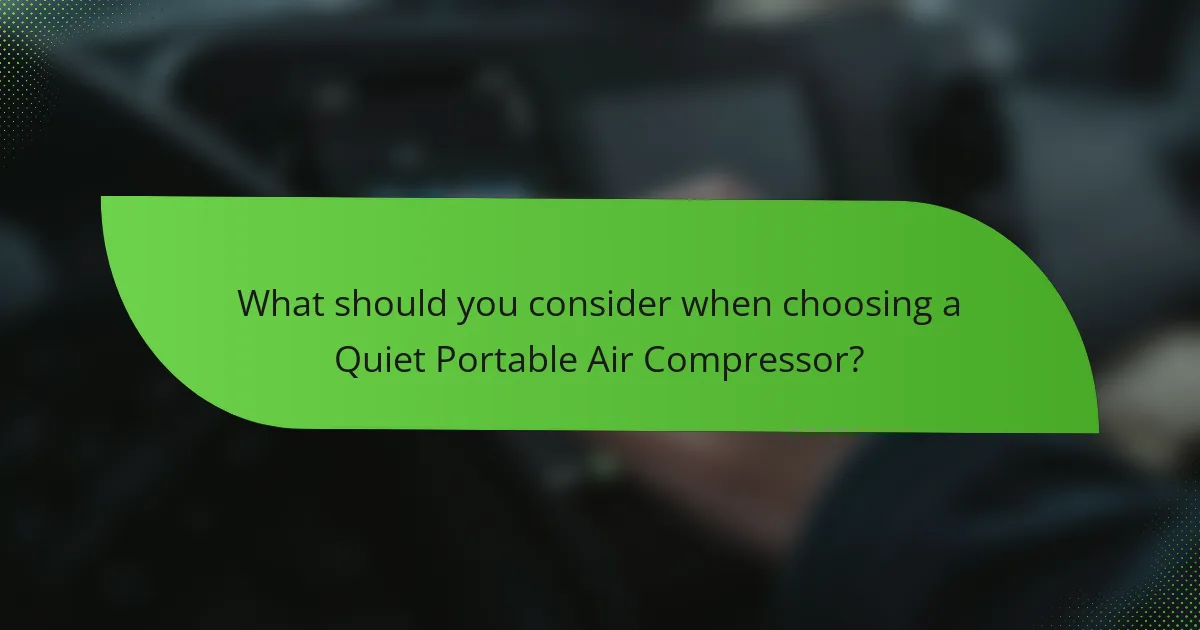
What should you consider when choosing a Quiet Portable Air Compressor?
When choosing a Quiet Portable Air Compressor, consider its noise level, portability, and power output. Noise level is crucial; look for models under 60 decibels for quieter operation. Portability involves weight and size; lighter models are easier to transport. Power output, measured in horsepower or PSI, determines the compressor’s efficiency for tasks. Additionally, check the tank size for air storage capacity. Evaluate the type of motor; oil-free motors require less maintenance. Lastly, consider the warranty and customer support for long-term reliability.
What specifications are important for selecting the right model?
Key specifications for selecting the right quiet portable air compressor include noise level, tank size, and power output. Noise level is crucial as it determines how disruptive the compressor will be during operation. A model with a lower decibel rating is preferable for quiet environments. Tank size affects the compressor’s runtime and ability to handle tasks without frequent cycling. Larger tanks can store more air, allowing for longer use between refills. Power output, measured in horsepower or watts, influences the compressor’s efficiency and capability to power tools. Higher power ratings typically mean better performance. Additionally, portability features such as weight and handle design can impact ease of transport. These specifications ensure the selected model meets user needs effectively.
How does tank size impact performance and noise levels?
Tank size directly impacts the performance and noise levels of portable air compressors. A larger tank typically allows for longer run times between refills. This reduces the frequency of the compressor cycling on and off. Consequently, this leads to lower overall noise levels during operation. For instance, a 6-gallon tank may run for 30 minutes before needing a refill, while a smaller 1-gallon tank might need to refill every 10 minutes.
Additionally, larger tanks can provide a more consistent air pressure, enhancing performance for demanding tasks. Research indicates that compressors with larger tanks often operate at lower decibel levels. This is because they can maintain pressure without constant motor engagement. Therefore, the relationship between tank size and noise levels is significant, with larger tanks generally leading to quieter operation.
What power source options are available for these compressors?
Quiet portable air compressors are typically powered by electricity, gasoline, or battery. Electric compressors are the most common option. They are suitable for indoor use and provide consistent power. Gasoline-powered compressors are ideal for outdoor use. They offer portability and high power but produce noise and emissions. Battery-operated compressors are convenient for small tasks. They provide mobility without cords but have limited runtime. Each power source option caters to different needs and environments.
What are some tips for maintaining Quiet Portable Air Compressors?
Regularly check the oil levels in your quiet portable air compressor. Maintaining proper oil levels ensures optimal performance and longevity. Change the oil as recommended by the manufacturer, typically every 50-100 hours of use. Clean or replace the air filter periodically to maintain airflow efficiency. Inspect hoses and connections for leaks or wear. Tighten any loose fittings to prevent air loss. Drain the moisture from the tank after each use to prevent rust. Store the compressor in a dry, cool place to avoid damage. Following these tips can significantly enhance the lifespan and performance of your quiet portable air compressor.
How can regular maintenance extend the lifespan of the compressor?
Regular maintenance can significantly extend the lifespan of a compressor. Routine checks ensure that components are clean and functioning properly. This prevents overheating, which is a common cause of compressor failure. Regular oil changes minimize friction and wear on moving parts. Checking and replacing air filters helps maintain optimal airflow and efficiency. Tightening loose connections prevents leaks that can lead to pressure loss. Monitoring and adjusting pressure settings ensures the compressor operates within safe limits. According to the U.S. Department of Energy, proper maintenance can increase equipment lifespan by up to 30%.
What common troubleshooting steps can be taken for noise issues?
Common troubleshooting steps for noise issues include checking for loose parts. Tightening screws and bolts can reduce vibrations. Inspecting the air filter for clogs is also important. A dirty filter can increase noise levels. Additionally, ensuring the compressor is on a stable surface helps minimize noise. Using rubber mats can absorb vibrations. Lastly, checking for any obstructions near the compressor can prevent excessive noise. These steps are essential for maintaining optimal performance and reducing noise in portable air compressors.
Quiet portable air compressors are compact devices designed to operate with minimal noise, typically below 60 decibels, making them suitable for indoor and residential use. This article explores the key characteristics, technologies, and noise levels associated with these compressors, highlighting their advantages over traditional models. It also discusses ideal applications in home settings and various professional fields, along with maintenance tips to enhance performance and longevity. Additionally, considerations for selecting the right model, including power source options and tank size, are examined to provide a comprehensive understanding of quiet portable air compressors.
